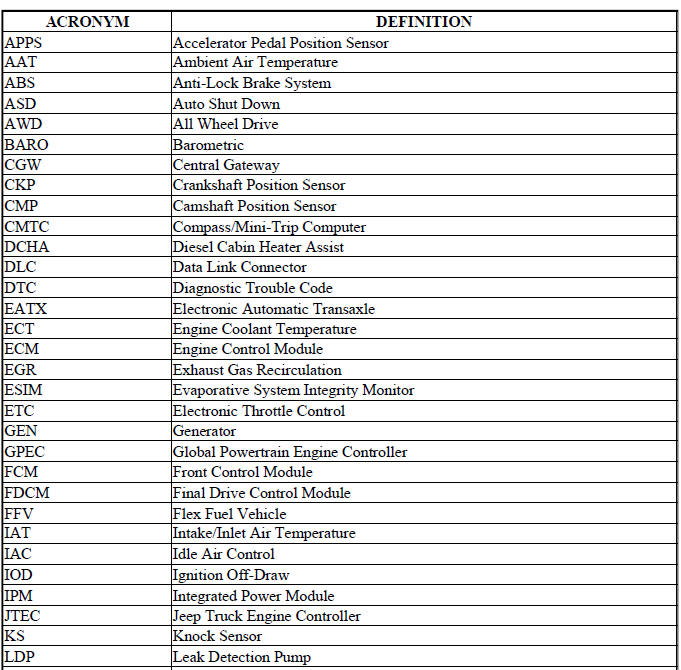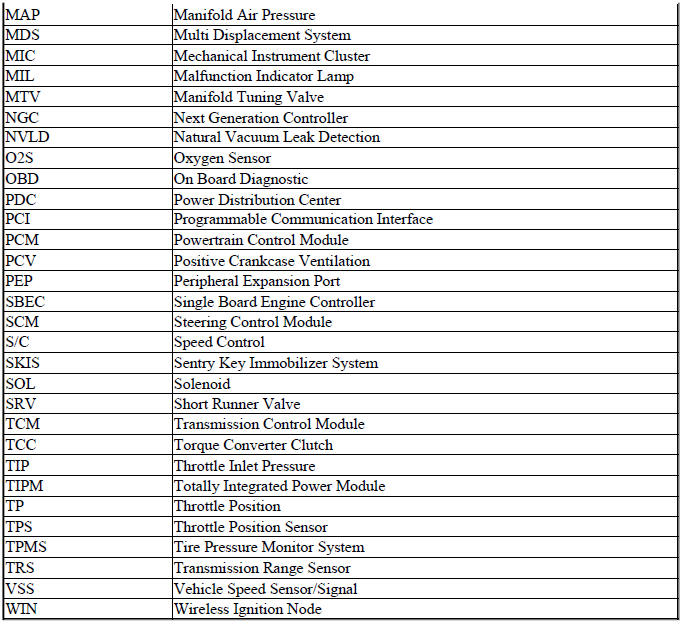Dodge Journey: Description, Operation
DESCRIPTION


OPERATION
The following procedure has been established to assist technicians in the field with enabling and running OBD II Monitors. The order listed in the following procedure is intended to allow the technician to effectively complete each monitor and to set the CARB Readiness Status in the least time possible.
NOTE: Once the monitor run process has begun, do not turn off the ignition. By turning the ignition key off, monitor enabling conditions will be lost. EVAP Monitor runs after key off. By performing a Battery Disconnect, or Selecting Erase DTCs, the CARB Readiness and all additional OBD II information will be cleared.
Monitor Preliminary Checks:
1. Plug a scan tool into the vehicle's Data Link Connector (DLC).
2. Turn the ignition, KEY ON - ENGINE OFF. Watch for the MIL lamp illumination during the bulb check.
MIL lamp must illuminate, if not, repair MIL lamp.
3. Using a scan tool check for Powertrain related DTCs.
NOTE: Only the monitors, which are not YES in the CARB Readiness Status, need to be completed. Specific criteria need to be met for each monitor. The most efficient order to run the monitors has been outlined below, including suggestions to aid the process.
- Verify that No Emissions Related DTCs are Present. If an Emissions DTC is Present, the OBD II Monitors may not run and the CARB Readiness will not update.
- The Emissions related DTC, will need to be repaired, then cleared. By clearing DTCs, the OBD Monitors will need to be run and completed to set the CARB Readiness Status.
Using the scan tool check the CARB Readiness Status.
Do all the CARB Readiness Status Locations read YES?
- YES - all monitors have been completed and this vehicle is ready to be I/M or Emission Tested.
- NO - then the following procedure needs to be followed to run/complete all available monitors.
Evaporative Emission System Leak Detection with Purge Monitor
This monitor requires a cool down cycle, usually an overnight soak for at least 8 hours without the engine running. The ambient temperature must decrease overnight - parking the vehicle outside is advised. To run this test the fuel level must be between 15-85% full. Criteria for EVAP monitor:
- Engine off time greater than one hour.
- Fuel Level between 15% and 85%.
- Start Up ECT and IAT within 10ºC (18ºF).
- Vehicle started and run until Purge Monitor reports a result.
NOTE: If the vehicle does not report a result and the conditions where correct. It may take up to two weeks to fail the small leak monitor. DO NOT use this test to attempt to determine a fault. Use the appropriate service information procedure for finding a small leak. If there are no faults and the conditions are correct this test will run and report a pass. Note the Small leak test can find leaks less than 10 thousands of an inch. If a small leak is present it takes approximately one week of normal driving to report a failure.
Catalyst / O2 Monitor
The Catalyst and O2 Monitor information are acquired and processed at the same time. Most vehicles will need to be driven at highway speed (less than 50 mph) (73km/h) for a few minutes. Some vehicles run the monitor at idle in drive. If the vehicle is equipped with a manual transmission, using 4th gear may assist in meeting the monitor running criteria.
- Engine RPM between 1200 to 3000.
- Enginetemperature greater than 70ºC (158ºF)
- Engine run time greater than 92 seconds
- MAP between 10 - 20 kPa (7.5 - 15 Hg)
- Vehicle speed between 20 - 70 mph (29-103 km/h)
EGR Monitor
After the vehicle has reached the below conditions and during a throttle decel the EGR monitor will run.
- Engine RPM between 1375 - 2500
- Engine temperature greater than 70ºC (158ºF)
- Engine run time greater than 125 seconds
- Vehicle speed between 25 - 70 mph (37-103 km/h)
O2 Sensor Heater Monitor
This monitor is now continuously running once the heaters are energized. Pass information will be processed at power down.
Mis-Fire Monitor
The Misfire Monitor is a continuous two-trip monitor. The monitor uses two different tests/counters:
NOTE: The Adaptive Numerator must be learned before the PCM will run the Mis-Fire Monitor. The PCM updates the Adaptive Numerator at every key-ON, and is relearned after battery disconnect. The Misfire Monitor will not run until the Adaptive Numerator has updated since the last battery disconnect. If the Adaptive Numerator is equal to the default value then the PCM knows that the Adaptive Numerator has not been learned and does not permit the Misfire Monitor to run. If the Adaptive Numerator exceeds a calibrated percentage, the PCM sets a DTC for CKP NOT LEARNED and illuminates the MIL.
- 200 Revolution Counter - Looks for misfire that can cause immediate catalyst damage.
- 1000 Revolution Counter - Looks for misfire that can cause emissions to increase 1.5 times the Federal Test Procedure (FTP) standards. This test must also identify misfire percentages that might cause a "durability demonstration vehicle" to fail an Inspection and Maintenance Program tailpipe emissions test.
 Task manager
Task manager
Description
The PCM is responsible for efficiently coordinating the operation of all the
emissions-related components. The
PCM is also responsible for determining if the diagnostic systems are ope ...
See also:
AUTOSTICK — IF EQUIPPED
AutoStick is a driver-interactive transmission that offers
six manual ratio changes to provide you with more
control of the vehicle. AutoStick allows you to maximize
engine braking, eliminate undes ...
MEDIA CENTER 230 (REQ) — AM/FM STEREO RADIO AND 6–DISC CD/DVD CHANGER
(MP3/WMA AUX JACK)
NOTE: The radio sales code is located on the lower right
side of the radio faceplate.
REQ Radio
Operating Instructions - Radio Mode
NOTE: The ignition switch must be in the ON or ACC
position t ...
Description
Fig. 1: 2.7 Liter Engine
The 2.7 Liter (167 Cubic Inches) 60 degree V6 engine is a double overhead
camshaft design with hydraulic
lifters and four valves per cylinder. The engine does not have p ...

